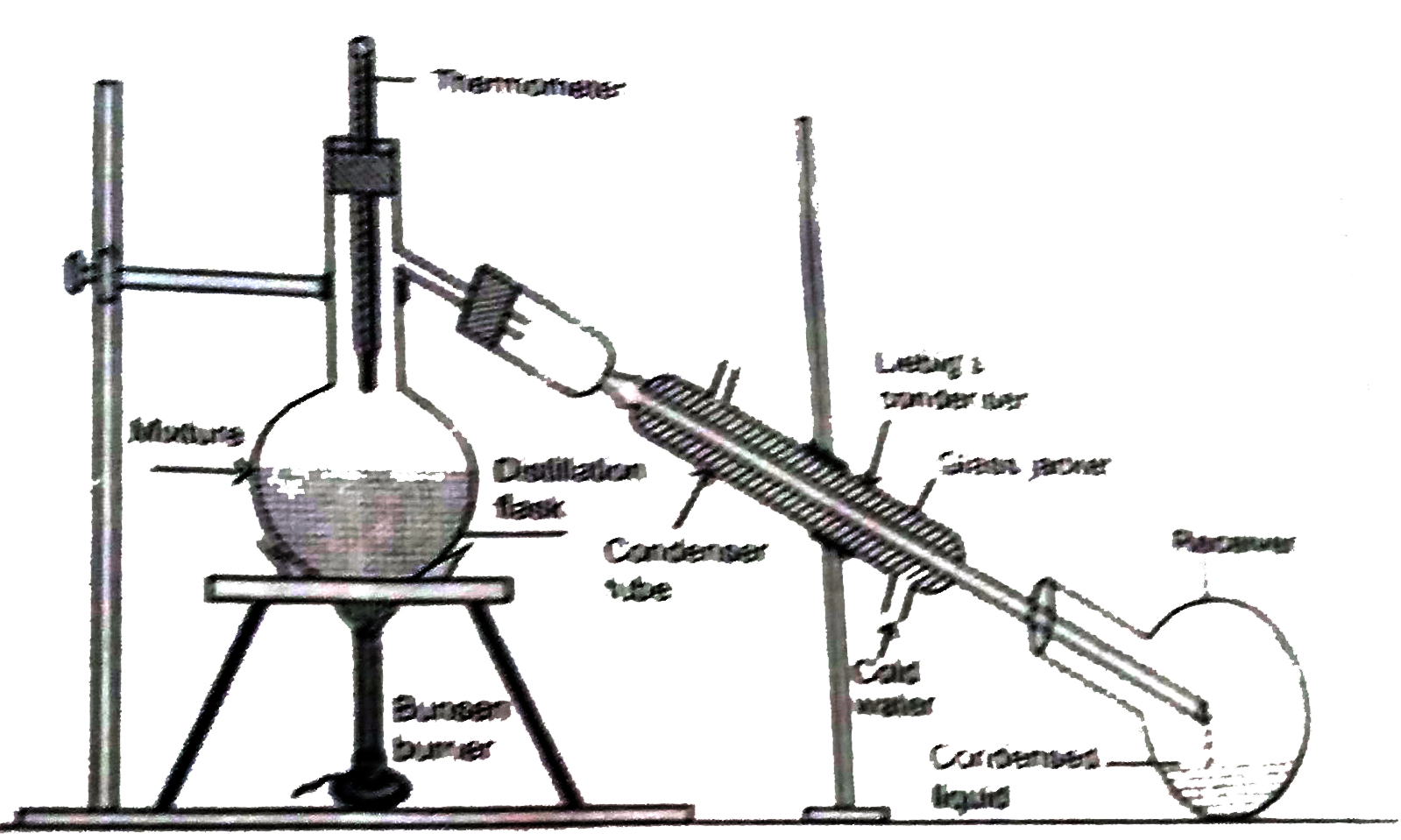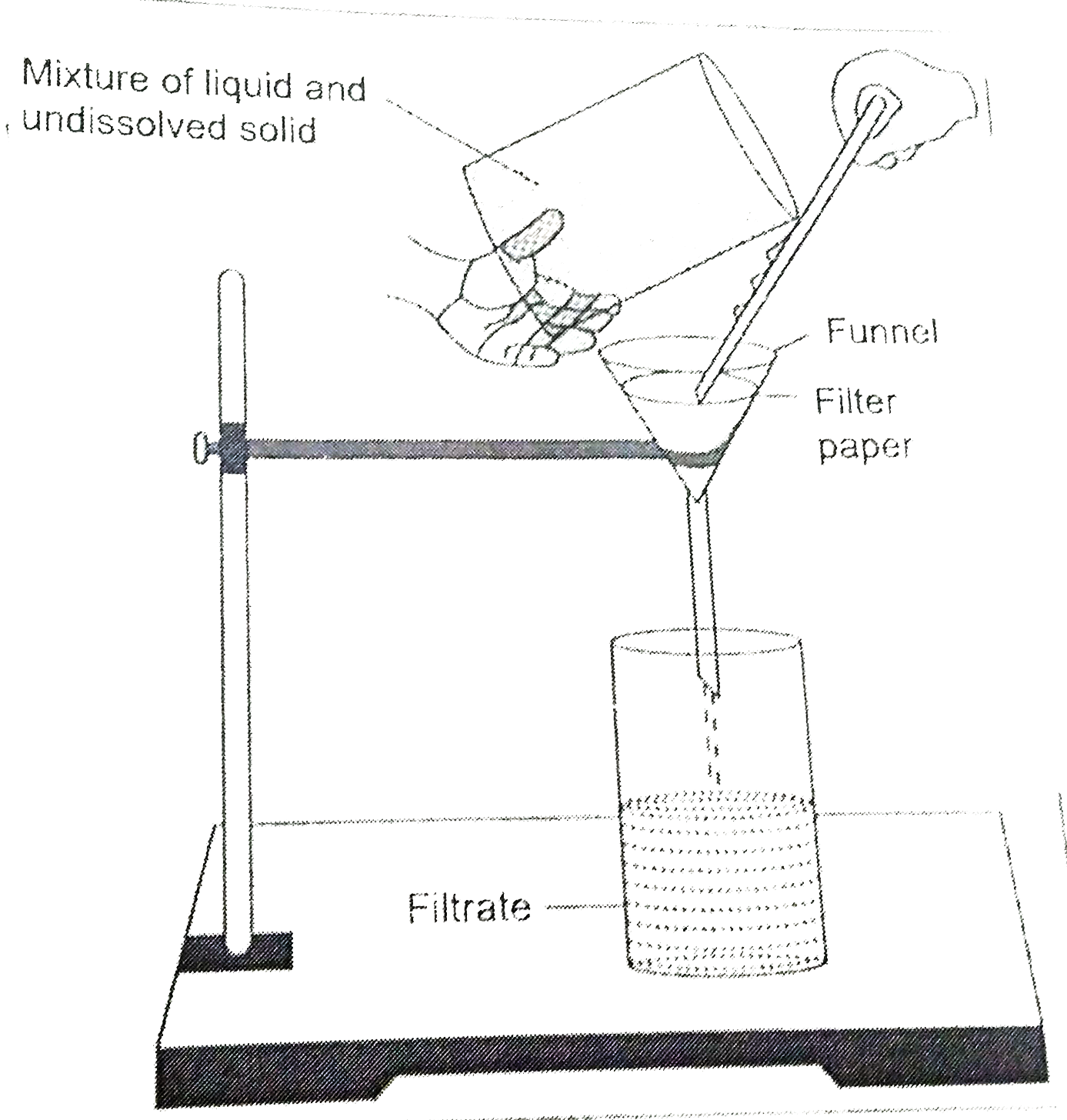Explain the following methods of separation with suitable exampls
(a) Distillation , (b) Filtration
(a) Distillation process
Process : The solution of copper sulphate is taken in a round bottom flask called distillation flask. A thermometer and a condenser, known as Liebig's condenser, are attached with the round bottom flask with the help of adapters. Liebig's condenser is a long glass tube enclosed in a jacket of glass Cold water is circulated through the glass jacket continuously.
The condenser leads to another flask called receiver to collect the liquid that gets separated from the solid during the process of distillation. The distillation flask is planced on a tripod stand and heated with the help of a Bunsen burner.
Observation : The solution starts boiling and water vapour obtained is passed through Liebig's condenser where it is converted to water due to condensation and collected in the receiver. Solid residue is observed in the distillation flask.
Conclusion : Water present in the solution is vapourised leaving behind the non-volatile solid that is copper sulphate in the distillation flask and thus constituents of the copper sulphate solution are separated.
(b) Filtration
All sorts of insoluble solids can be separated from the liquid in this process.
Process : A mixture of saw dust and water is taken in a beaker. A filter paper is folded in the form of a cone and fitted into a funnel by moistening it with a few drops of water. The mixture is poured gently into the filter cone and collected into another beaker.
Observation : The liquid collected is clear and transparent. Sawdust is found over the filter paper.
Conclusion : The mixture of sawdust and water is separated through filtration process. The clear liquid that is collected in the another beaker on the filter paper are known as residue.


Topper's Solved these Questions
- CLASSIFICATION OF MATTERBook:PEARSON IIT JEE FOUNDATIONChapter:CLASSIFICATION OF MATTERExercise:CONCEPT APPLICATION LEVEL-1
Explore 10 Videos
- CLASSIFICATION OF MATTERBook:PEARSON IIT JEE FOUNDATIONChapter:CLASSIFICATION OF MATTERExercise:CONCEPT APPLICATION LEVEL-1 FILL IN THE BLANKS
Explore 10 Videos
- CLASSIFICATION OF MATTERBook:PEARSON IIT JEE FOUNDATIONChapter:CLASSIFICATION OF MATTERExercise:SHORT-ANSWER TYPE QUESTIONS
Explore 16 Videos
- CLASSIFICATION OF MATTERBook:PEARSON IIT JEE FOUNDATIONChapter:CLASSIFICATION OF MATTERExercise:ASSESSMENT TEST (TEST-2)
Explore 9 Videos
- MOCK TESTBook:PEARSON IIT JEE FOUNDATIONChapter:MOCK TESTExercise:EXERCISE
Explore 25 Videos
Similar Questions
Explain the following reactions with suitable examples.
Gatterman reaction
View SolutionExplain redox reaction with suitable example.
View SolutionExplain redox reaction with suitable example.
View SolutionExplain the following reactions with suitable examples.
Sandmeyer reaction.
View SolutionExplain the following reactions with suitable examples.
Hofmann elimination reaction.
View SolutionExplain briefly the principles of insurance with suitable examples
View SolutionExplain the following terms with suitable examples :
(a) Cationic detergents (b) Anionic detergents
View SolutionExplain transitive relation with suitable examples.
View SolutionExplain the phenomenon of explosion with suitable examples.
View SolutionExplain the concept of 'Determinism" with suitable examples
View Solution
